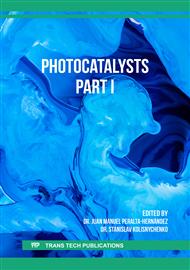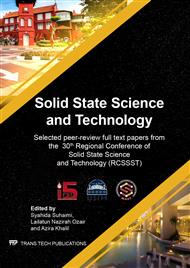p.192
p.201
p.207
p.217
p.223
p.231
p.247
p.252
p.258
Temperature and Salinity Effects on Photocatalytic Performance of Cerium Doped Zinc Oxide
Abstract:
Cerium (Ce) doped ZnO is a promising material for advanced photocatalysis. It is useful for inducing the treatment of many organic pollutants in water. However, the stability of its performance under varying temperature and saline condition has never been not fully assessed. In this study, powder form photocatalyst comprising 99.0 mol% ZnO and 1 mol% CeO2 has been synthesized via modified citrate gelation technique and solid-state sintering at 1200 °C for 5 hours. The conversion of Ce doped ZnO from its precursors has been confirmed using XRD, SEM, and EDX techniques. The photocatalytic efficiency of the synthesized Ce doped ZnO under UV-C light (λ=265 nm) was determined. In the experiment, the operating temperature was varied between 25 to 40 °C, and the salinity of the treated solution was increased from 0 to 40 g/L NaCl. The findings revealed that the photocatalytic efficiency of Ce doped ZnO under UV light improved from 78.2% to 88.6% as the temperature increased from 25 to 40 °C. The performance of Ce doped ZnO decreased from 86.7% to 36.7% when the salinity increased from 0 g/L to 40 g/L. The elevation of temperature encouraged the photogeneration of electron-hole pairs on catalyst surface while the presence of chloride ions in treated medium caused scavenging of hydroxyl radicals or hole.
Info:
Periodical:
Pages:
223-228
Citation:
Online since:
July 2020
Keywords:
Price:
Сopyright:
© 2020 Trans Tech Publications Ltd. All Rights Reserved
Share:
Citation:



